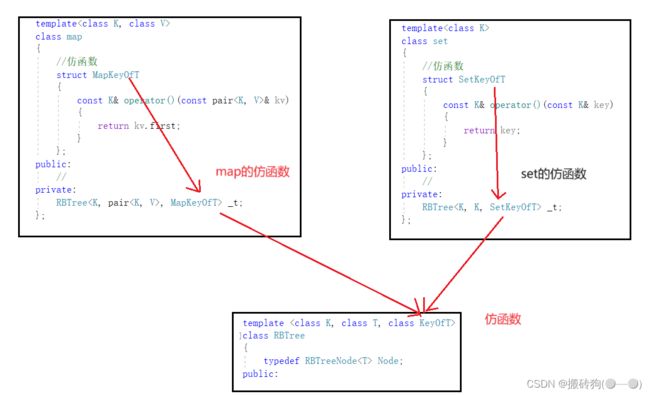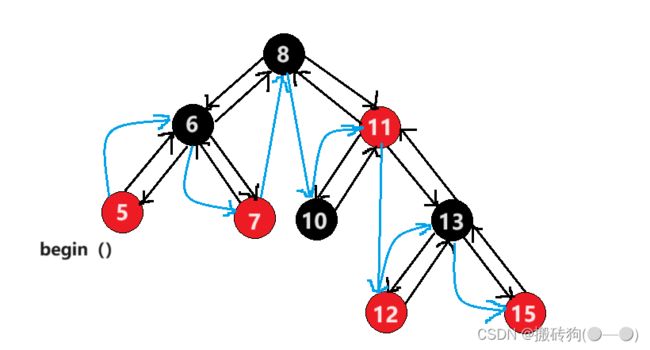C++之模拟实现map和set
模拟实现map和set
- 红黑树源代码
- 红黑树模板参数控制
- 红黑树结点当中存储的数据
- 仿函数的增加
- 正向迭代器的实现
-
- * 运算符重载
- ->运算符重载
- !=和==运算符重载
- ++运算符重载
- - -运算符重载
- begin()与end()实现
- set的模拟实现
- map的模拟实现
- 封装后红黑树代码
红黑树源代码
#pragma once
enum color
{
BLACK,
RED
};
template<class K, class V>
struct RBTreeNode
{
//三叉链
RBTreeNode<K, V>* _left;
RBTreeNode<K, V>* _right;
RBTreeNode<K, V>* _parent;
//存储的键值对
pair<K, V> _kv;
//结点的颜色
color _col; //红/黑
//构造函数
RBTreeNode(const pair<K, V>& kv)
:_left(nullptr)
, _right(nullptr)
, _parent(nullptr)
, _kv(kv)
, _col(RED)
{}
};
template <class K, class V>
class RBTree
{
typedef RBTreeNode<K, V> Node;
public:
bool Insert(const pair<K, V>& kv)
{
//根结点为空
if (_root == nullptr)
{
//创建根结点
_root = new Node(kv);
//颜色变为黑
_root->_col = BLACK;
return true;
}
Node* cur = _root;
Node* parent = nullptr;
while (cur)
{
//如果插入key值小于根结点key值
if (cur->_kv.first > kv.first)
{
parent = cur;
cur = cur->_left;
}
//如果插入key值大于根结点key值
else if (cur->_kv.first < kv.first)
{
parent = cur;
cur = cur->_right;
}
//相等,返回false
else
{
return false;
}
}
//创建cur结点
cur = new Node(kv);
//颜色初始化为红色
cur->_col = RED;
//如果插入key值小于parent结点key值
if (parent->_kv.first > kv.first)
{
//在左边插入
parent->_left = cur;
}
//如果插入key值大于parent结点key值
else
{
//在右边插入
parent->_right = cur;
}
//跟父结点连接起来
cur->_parent = parent;
while (parent && parent->_col == RED)
{
//定义祖父节点
Node* grandfather = parent->_parent;
assert(grandfather);
assert(grandfather->_col == BLACK);
//如果父结点在祖父节点左边
if (parent == grandfather->_left)
{
//定义叔叔结点在祖父结点右边
Node* uncle = grandfather->_right;
//情况一:
//叔叔结点存在且为红
if (uncle && uncle->_col == RED)
{
//进行颜色调整
parent->_col = uncle->_col = BLACK;
grandfather->_col = RED;
//继续向上调整
cur = grandfather;
parent = cur->_parent;
}
//情况二和三:
//叔叔结点不存在或者存在且为黑
else
{
//插入结点在父结点左边
if (cur == parent->_left)
{
//右单旋+颜色调整
RotateR(grandfather);
grandfather->_col = RED;
parent->_col = BLACK;
}
//插入结点在父结点左边
else
{
//左右双旋+颜色调整
RotateL(parent);
RotateR(grandfather);
cur->_col = BLACK;
grandfather->_col = RED;
}
break;
}
}
//如果父结点在祖父节点右边
else
{
//定义叔叔结点在祖父结点左边
Node* uncle = grandfather->_left;
//情况一:
//叔叔结点存在且为红
if (uncle && uncle->_col == RED)
{
//颜色调整
parent->_col = uncle->_col = BLACK;
grandfather->_col = RED;
//向上调整
cur = grandfather;
parent = cur->_parent;
}
//情况二和三:
//叔叔结点不存在或者存在且为黑
else
{
//插入结点在父结点右边
if (cur == parent->_right)
{
//左单旋+颜色调整
RotateL(grandfather);
grandfather->_col = RED;
parent->_col = BLACK;
}
//插入结点在父结点左边
else
{
//右左双旋+颜色调整
RotateR(parent);
RotateL(grandfather);
cur->_col = BLACK;
grandfather->_col = RED;
}
break;
}
}
}
//根结点变为黑色
_root->_col = BLACK;
return true;
}
private:
void RotateL(Node* parent)
{
//记录parent结点的父结点
Node* ppNode = parent->_parent;
Node* subR = parent->_right;
Node* subRL = subR->_left;
//建立parent与subRL之间的关系
parent->_right = subRL;
if (subRL)
subRL->_parent = parent;
//建立parent与subR之间的关系
subR->_left = parent;
parent->_parent = subR;
//判断根结点是否就是parent
if (_root == parent)
{
_root = subR;
subR->_parent = nullptr;
}
else
{
if (ppNode->_left == parent)
{
ppNode->_left = subR;
}
else
{
ppNode->_right = subR;
}
subR->_parent = ppNode;
}
}
void RotateR(Node* parent)
{
Node* subL = parent->_left;
Node* subLR = subL->_right;
Node* ppNode = parent->_parent;
//建立subLR与parent关系
parent->_left = subLR;
if (subLR)
subLR->_parent = parent;
//建立subL与parent关系
subL->_right = parent;
parent->_parent = subL;
//判断根结点是否就是parent
if (_root == parent)
{
_root = subL;
subL->_parent = nullptr;
}
else
{
if (ppNode->_left == parent)
{
ppNode->_left = subL;
}
else
{
ppNode->_right = subL;
}
subL->_parent = ppNode;
}
}
private:
Node* _root = nullptr;
};
红黑树模板参数控制
我们可以知道,set属于K模型的容器,map属于KV模型的容器,那我们如何使用一棵红黑树来实现map和set呢?
我们就需要控制map和set传入底层红黑树的模板参数,为了与原红黑树的模板参数进行区分,我们将红黑树第二个模板参数的名字改为T。
template <class K, class T>
class RBTree
{
typedef RBTreeNode<T> Node;
public:
//....
private:
Node* _root = nullptr;
T模板参数可能只是键值Key,也可能是由Key和Value共同构成的键值对。如果是set容器,那么它传入底层红黑树的模板参数就是Key和Key:
namespace gtt
{
template<class K>
class set
{
public:
//
private:
RBTree<K, K> _t;
};
}
map它传入底层红黑树的模板参数就是Key以及Key和Value构成的键值对:
namespace gtt
{
template<class K, class V>
class map
{
public:
//
private:
RBTree<K, pair<K, V>> _t;
};
}
我们需要注意的是模板中第一个参数K是不可以省略掉的,对于set容器来说第一个参数K和第二个参数K都是一样的,并不会影响什么,对于map容器来说,进行find或者erase时,我们依然需要返回一个key类型的迭代器,所以第一个K不可以省略。
红黑树结点当中存储的数据
对于上层结构:
- map:K代表键值Key,T代表由Key和Value构成的键值对。
- set容器:K和T都代表键值Key。
对于set容器来说,底层红黑树结点当中存储K和T都是一样的,但是对于map容器来说,底层红黑树就只能存储T了。由于底层红黑树并不知道上层容器到底是map还是set,因此红黑树的结点当中直接存储T就行了,这样一来,当上层容器是set的时候,结点当中存储的是键值Key;当上层容器是map的时候,结点当中存储的就是

代码如下:
template<class T>
struct RBTreeNode
{
//三叉链
RBTreeNode<T>* _left;
RBTreeNode<T>* _right;
RBTreeNode<T>* _parent;
//存储数据
T _data;
//结点的颜色
color _col; //红/黑
//构造函数
RBTreeNode(const T& data)
:_left(nullptr)
, _right(nullptr)
, _parent(nullptr)
,_data(data)
, _col(RED)
{}
};
仿函数的增加
对于set容器,我们需要进行键值比较就是对key值进行比较,也就是直接比较T就可以了,但是对于map容器来说,我们需要比较的是键值对
所以,我们需要在上层map和set中各提供一个仿函数,根据传入的T类型分开进行比较操作:
set仿函数:
namespace gtt
{
template<class K>
class set
{
//仿函数
struct SetKeyOfT
{
const K& operator()(const K& key)
{
return key;
}
};
public:
//
private:
RBTree<K, K, SetKeyOfT> _t;
};
}
map仿函数:
namespace gtt
{
template<class K, class V>
class map
{
//仿函数
struct MapKeyOfT
{
const K& operator()(const pair<K, V>& kv)
{
return kv.first;
}
};
public:
//
private:
RBTree<K, pair<K, V>, MapKeyOfT> _t;
};
}
我们提供了仿函数以后,在进行传参的过程,编译器就会识别我们是需要调用map进行比较还是调用set进行比较,不同的容器调用不同的比较方式:

正向迭代器的实现
红黑树的正向迭代器实际上就是对结点指针进行了封装,因此在正向迭代器当中实际上就只有一个成员变量,那就是正向迭代器所封装结点的指针。
template<class T, class Ref, class Ptr>
struct __TreeIterator
{
typedef RBTreeNode<T> Node;
typedef __TreeIterator<T, Ref, Ptr> Self;
Node* _node;
//构造函数
__TreeIterator(Node* node)
:_node(node)
{}
};
* 运算符重载
解引用操作,我们直接返回结点数据的引用即可:
//解引用
Ref operator*()
{
return _node->_data;
}
->运算符重载
->也就是返回结点数据的地址:
//->
Ptr operator->()
{
return &(_node->_data);
}
!=和==运算符重载
!=和==就是判断两个迭代器所封装的结点是否是同一个
//不等于
bool operator!=(const Self& s) const
{
return _node != s._node;
}
++运算符重载
红黑树的正向迭代器时,一个结点的正向迭代器进行++操作后,应该根据红黑树中序遍历的序列找到当前结点的下一个结点。
逻辑就是:
Self& operator++()
{
//右子树不为空,就去找右子树中最左节点
if (_node->_right)
{
Node* left = _node->_right;
while (left->_left)
{
left = left->_left;
}
//++后变为该结点
_node = left;
}
//右子树为空,就去找孩子不在父亲右的祖先
else
{
Node* parent = _node->_parent;
Node* cur = _node;
while (parent && cur == parent->_right)
{
cur = parent;
parent = parent->_parent;
}
//++后变为该结点
_node = parent;
}
return *this;
}
- -运算符重载
红黑树的正向迭代器时,一个结点的正向迭代器进行–操作后,应该根据红黑树中序遍历的序列找到当前结点的前一个结点:
逻辑如下:
- 如果当前结点的左子树不为空,则–操作后应该找到其左子树当中的最右结点。
- 如果当前结点的左子树为空,则–操作后应该在该结点的祖先结点中,找到孩子不在父亲左的祖先。
代码如下:
Self& operator--()
{
//左子树不为空,就去找左子树中最右节点
if (_node->_left)
{
Node* right = _node->_left;
while (right->_right)
{
right = right->_right;
}
//--后变为该结点
_node = right;
}
//左子树为空,就去找孩子不在父亲左的祖先
else
{
Node* parent = _node->_parent;
Node* cur = _node;
while (parent && cur == parent->_left)
{
cur = parent;
parent = parent->_parent;
}
//--变为该结点
_node = parent;
}
}
begin()与end()实现
- begin函数返回中序序列当中第一个结点的正向迭代器,即最左结点。
- end函数返回中序序列当中最后一个结点下一个位置的正向迭代器,这里直接用空指针构造一个正向迭代器。
template <class K, class T, class KeyOfT>
class RBTree
{
typedef RBTreeNode<T> Node;
public:
typedef __TreeIterator<T, T&, T*> iterator;//正向迭代器
iterator begin()
{
Node* left = _root;
//寻找最左结点
while (left && left->_left)
{
left = left->_left;
}
//返回最左结点的正向迭代器
return iterator(left);
}
iterator end()
{
//返回由nullptr构造得到的正向迭代器
return iterator(nullptr);
}
private:
Node* _root = nullptr;
set的模拟实现
namespace gtt
{
template<class K>
class set
{
//仿函数
struct SetKeyOfT
{
const K& operator()(const K& key)
{
return key;
}
};
public:
typedef typename RBTree<K, K, SetKeyOfT>::iterator iterator;
//begin()
iterator begin()
{
//调用红黑树的begin()
return _t.begin();
}
//end()
iterator end()
{
//调用红黑树的end()
return _t.end();
}
//插入函数
pair<iterator, bool> Insert(const K& key)
{
//调用红黑树的Insert
return _t.Insert(key);
}
private:
RBTree<K, K, SetKeyOfT> _t;
};
map的模拟实现
namespace gtt
{
template<class K, class V>
class map
{
//仿函数
struct MapKeyOfT
{
const K& operator()(const pair<K, V>& kv)
{
return kv.first;
}
};
public:
typedef typename RBTree<K, pair<K, V>, MapKeyOfT>::iterator iterator;
//begin()
iterator begin()
{
return _t.begin();
}
//end()
iterator end()
{
return _t.end();
}
//插入函数
pair<iterator, bool> Insert(const pair<K, V>& kv)
{
return _t.Insert(kv);
}
//[]运算符重载
V& operator[](const K& key)
{
pair<iterator, bool> ret = Insert(make_pair(key, V()));
return ret.first->second;
}
private:
RBTree<K, pair<K, V>, MapKeyOfT> _t;
};
封装后红黑树代码
#pragma once
enum color
{
BLACK,
RED
};
template<class T>
struct RBTreeNode
{
//三叉链
RBTreeNode<T>* _left;
RBTreeNode<T>* _right;
RBTreeNode<T>* _parent;
//存储数据
T _data;
//结点的颜色
color _col; //红/黑
//构造函数
RBTreeNode(const T& data)
:_left(nullptr)
, _right(nullptr)
, _parent(nullptr)
,_data(data)
, _col(RED)
{}
};
template<class T, class Ref, class Ptr>
struct __TreeIterator
{
typedef RBTreeNode<T> Node;
typedef __TreeIterator<T, Ref, Ptr> Self;
Node* _node;
//构造函数
__TreeIterator(Node* node)
:_node(node)
{}
//解引用
Ref operator*()
{
return _node->_data;
}
//->
Ptr operator->()
{
return &(_node->_data);
}
//不等于
bool operator!=(const Self& s) const
{
return _node != s._node;
}
//等于
bool operator==(const Self& s) const
{
return _node == s._node;
}
Self& operator++()
{
//右子树不为空,就去找右子树中最左节点
if (_node->_right)
{
Node* left = _node->_right;
while (left->_left)
{
left = left->_left;
}
//++后变为该结点
_node = left;
}
//右子树为空,就去找孩子不在父亲右的祖先
else
{
Node* parent = _node->_parent;
Node* cur = _node;
while (parent && cur == parent->_right)
{
cur = parent;
parent = parent->_parent;
}
//++后变为该结点
_node = parent;
}
return *this;
}
Self& operator--()
{
//左子树不为空,就去找左子树中最右节点
if (_node->_left)
{
Node* right = _node->_left;
while (right->_right)
{
right = right->_right;
}
//--后变为该结点
_node = right;
}
//左子树为空,就去找孩子不在父亲左的祖先
else
{
Node* parent = _node->_parent;
Node* cur = _node;
while (parent && cur == parent->_left)
{
cur = parent;
parent = parent->_parent;
}
//--变为该结点
_node = parent;
}
}
};
template <class K, class T, class KeyOfT>
class RBTree
{
typedef RBTreeNode<T> Node;
public:
typedef __TreeIterator<T, T&, T*> iterator;//正向迭代器
iterator begin()
{
Node* left = _root;
//寻找最左结点
while (left && left->_left)
{
left = left->_left;
}
//返回最左结点的正向迭代器
return iterator(left);
}
iterator end()
{
//返回由nullptr构造得到的正向迭代器
return iterator(nullptr);
}
pair<iterator, bool> Insert(const T& data)
{
KeyOfT kot;
//根结点为空
if (_root == nullptr)
{
//创建根结点
_root = new Node(data);
//颜色变为黑
_root->_col = BLACK;
return make_pair(iterator(_root), true);
}
Node* cur = _root;
Node* parent = nullptr;
while (cur)
{
//如果插入key值小于根结点key值
if (kot(cur->_data) > kot(data))
{
parent = cur;
cur = cur->_left;
}
//如果插入key值大于根结点key值
else if (kot(cur->_data) < kot(data))
{
parent = cur;
cur = cur->_right;
}
//相等,返回false
else
{
return make_pair(iterator(cur), false);
}
}
//创建cur结点
cur = new Node(data);
Node* newnode = cur;
//颜色初始化为红色
cur->_col = RED;
//如果插入key值小于parent结点key值
if (kot(parent->_data) > kot(data))
{
//在左边插入
parent->_left = cur;
}
//如果插入key值大于parent结点key值
else
{
//在右边插入
parent->_right = cur;
}
//跟父结点连接起来
cur->_parent = parent;
while (parent && parent->_col == RED)
{
//定义祖父节点
Node* grandfather = parent->_parent;
assert(grandfather);
assert(grandfather->_col == BLACK);
//如果父结点在祖父节点左边
if (parent == grandfather->_left)
{
//定义叔叔结点在祖父结点右边
Node* uncle = grandfather->_right;
//情况一:
//叔叔结点存在且为红
if (uncle && uncle->_col == RED)
{
//进行颜色调整
parent->_col = uncle->_col = BLACK;
grandfather->_col = RED;
//继续向上调整
cur = grandfather;
parent = cur->_parent;
}
//情况二和三:
//叔叔结点不存在或者存在且为黑
else
{
//插入结点在父结点左边
if (cur == parent->_left)
{
//右单旋+颜色调整
RotateR(grandfather);
grandfather->_col = RED;
parent->_col = BLACK;
}
//插入结点在父结点左边
else
{
//左右双旋+颜色调整
RotateL(parent);
RotateR(grandfather);
cur->_col = BLACK;
grandfather->_col = RED;
}
break;
}
}
//如果父结点在祖父节点右边
else
{
//定义叔叔结点在祖父结点左边
Node* uncle = grandfather->_left;
//情况一:
//叔叔结点存在且为红
if (uncle && uncle->_col == RED)
{
//颜色调整
parent->_col = uncle->_col = BLACK;
grandfather->_col = RED;
//向上调整
cur = grandfather;
parent = cur->_parent;
}
//情况二和三:
//叔叔结点不存在或者存在且为黑
else
{
//插入结点在父结点右边
if (cur == parent->_right)
{
//左单旋+颜色调整
RotateL(grandfather);
grandfather->_col = RED;
parent->_col = BLACK;
}
//插入结点在父结点左边
else
{
//右左双旋+颜色调整
RotateR(parent);
RotateL(grandfather);
cur->_col = BLACK;
grandfather->_col = RED;
}
break;
}
}
}
//根结点变为黑色
_root->_col = BLACK;
return make_pair(iterator(newnode), true);
}
void RotateL(Node* parent)
{
//记录parent结点的父结点
Node* ppNode = parent->_parent;
Node* subR = parent->_right;
Node* subRL = subR->_left;
//建立parent与subRL之间的关系
parent->_right = subRL;
if (subRL)
subRL->_parent = parent;
//建立parent与subR之间的关系
subR->_left = parent;
parent->_parent = subR;
//判断根结点是否就是parent
if (_root == parent)
{
_root = subR;
subR->_parent = nullptr;
}
else
{
if (ppNode->_left == parent)
{
ppNode->_left = subR;
}
else
{
ppNode->_right = subR;
}
subR->_parent = ppNode;
}
}
void RotateR(Node* parent)
{
Node* subL = parent->_left;
Node* subLR = subL->_right;
Node* ppNode = parent->_parent;
//建立subLR与parent关系
parent->_left = subLR;
if (subLR)
subLR->_parent = parent;
//建立subL与parent关系
subL->_right = parent;
parent->_parent = subL;
//判断根结点是否就是parent
if (_root == parent)
{
_root = subL;
subL->_parent = nullptr;
}
else
{
if (ppNode->_left == parent)
{
ppNode->_left = subL;
}
else
{
ppNode->_right = subL;
}
subL->_parent = ppNode;
}
}
private:
Node* _root = nullptr;
};
